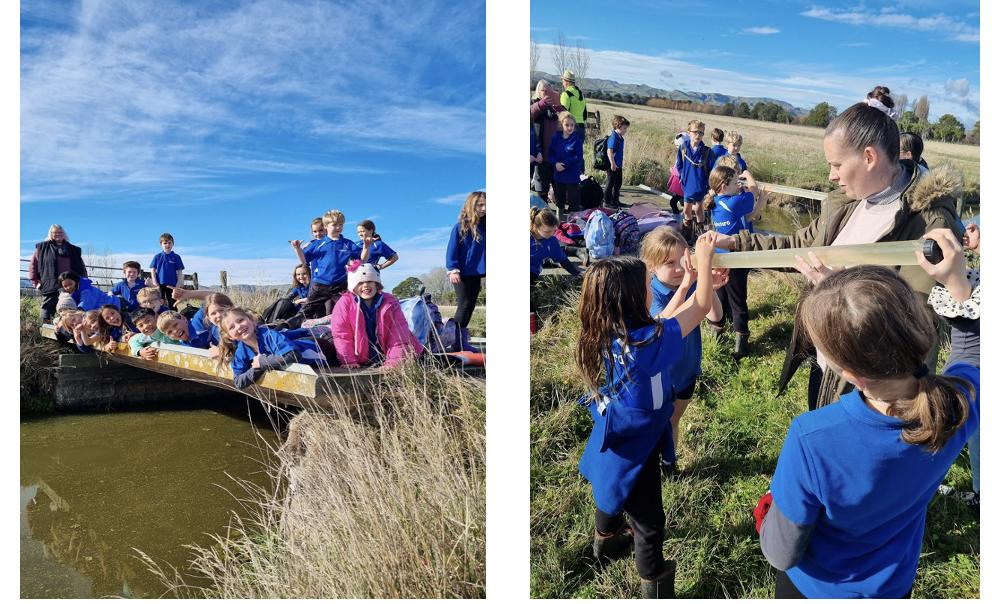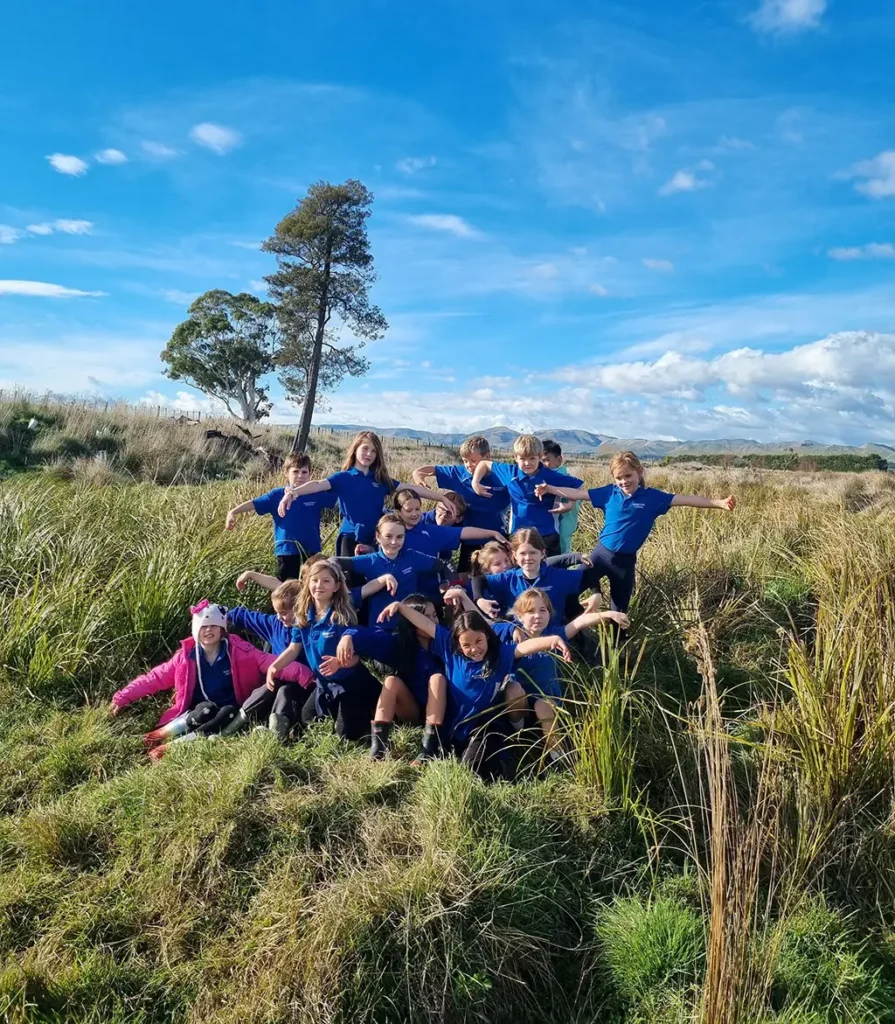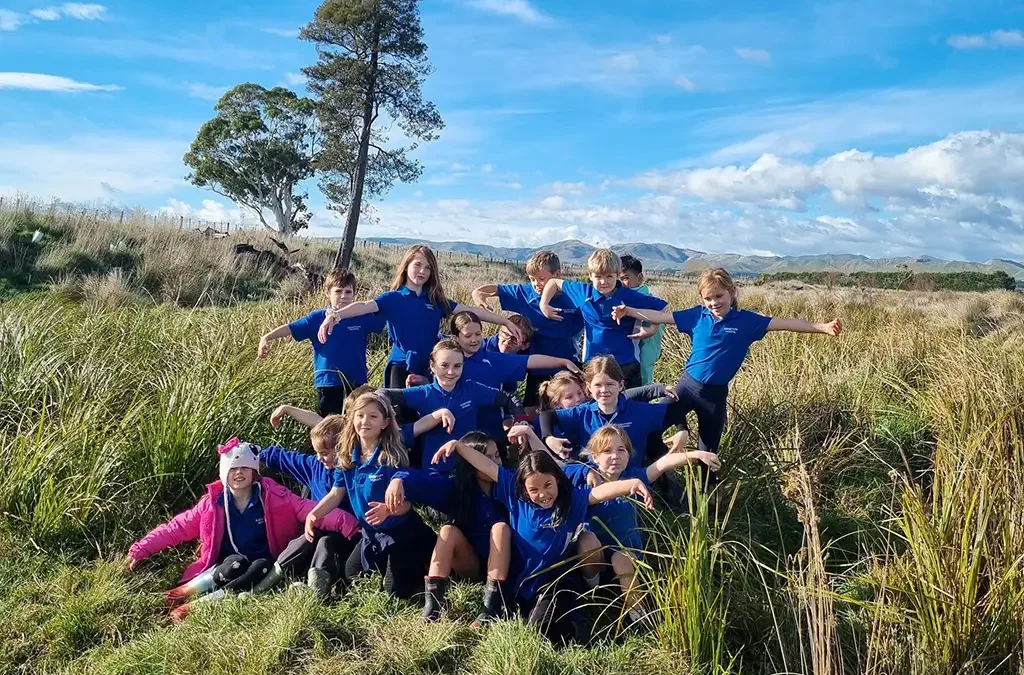Over the last few months our Te Reo o te Wai project has taken us on a journey with a year 3 and 4 class from Kahutara School . We have travelled alongside the twists and turns of the Ruamāhanga river and all that live in and around her waters. We have observed and learned many things; starting with how easily children can slip into an age-old connection with the natural world.
On each of the field trips, Rod and I have helped the children experience a few minutes of silence and stillness on the bank above the river; encouraging them with the idea that nature opens up and comes closer to us when we are quiet. On this particular morning it seemed that as soon as everyone settled the birds came more clearly into view. We saw shag and pūkeko by the river and nesting in trees, heard tui and of course our friend piwakawaka came by to see what was going on. Just as I was writing this an email arrived from Joe Howells, our friend and that days’ driver of the Green Jersey bus. He wrote “The small bird on the river’s edge today was probably Ngatu Pare or Wrybill, the white bird we saw was a white swallow. They are quite rare, apparently there is a one in 18,000 chance of seeing one”

It is helpful to recall that there was a time when human beings were much more intimately involved in the landscape, where our very language mimicked and was developed from the music of the earth itself. We not only listen to the earth, it listens to us. – David Abram from the Spell of the Sensuous
I like the idea that some stories are half made by humans and half made by the earth. With our senses more tuned to the colour, the sounds and the smell of the landscape, the smallest child leaned forward and asked, “who’s telling a story today?” Whilst not everyone may agree, mythologist Karen Armstrong claims that myths carry a universal licence to be told in different ways depending on the context. We have seen how, like the river itself, the stories we have each told, have changed and adapted to meet the setting we are in. That morning I told a contemporary version of the traditional Māori legend, The Three Baskets of Knowledge. I have told the story in many different ways over the years, most often in the concrete terrain in the middle of London. On this occasion it was a call for action version of the story, about a boy called Sam wanting to grow a forest around three lonely kahikatea trees and the guidance he received. After telling the story, I asked the group, “What images did you see in your mind as you heard the story? ” The replies came thick and fast.
“…the different birds … the light coming through the leaves … the sand and the crashing waves … the different greens of the forest, the towering mātai trees…” The children’s descriptions echoed things we had seen on each of the field trips and it seemed that the story had no problem painting itself inside their heads. On the previous field trip Rod told an African story about a hummingbird that drew on the water of a river to save a forest and all the animals that lived there. That story called for a second telling. As you might imagine, most of the children knew that we live in the only country in the world where mammals arrived just several hundred years ago. They also knew that many of the mammals here are now predators threatening the birds in our forests.
Huge thanks go to the adaptability and creativity of Maddy Glover and Kara Kenny the fresh-water biologists from conservation charity Mountains to Sea, who are co-leading some of these sessions with us. Travelling hopefully they have set nets the evening before the Field Trips. There is no guarantee anything will be in them by the time the children come to inspect. This time the plan was to explore the water in the wetland and by the morning the nets were still empty. Undeterred, Kara had the children completely engaged with her action game and descriptions about the galactic fish that once swam in abundance in our Wairarapa rivers and wetlands. We learned about giant kōkopu, the largest species in the whitebait family, banded kōkopu, kōaro an excellent climber and inanga that likes to huddle up close to each other.

Despite the lack of fish the wetland still had many stories to tell. The concrete bridge at the head of the wetland was a good place to get a sense of the changes in the land. On the farm side of the fence the water is, like much of the Wairarapa plains, canalised into a drain and on the wetland side the drain is beginning to fill with grasses, widen and soften. Examining the quality of the water, with a conductivity metre and through a plastic clarity tube with a simple visual measuring device, proved to be a popular activity, indicating how many particles were present and how clean the water was. “Clean enough for some creatures to survive,” said Kara, “but not as clean as we would like it to be.” Further down the wetland the children measured again. Here, in large patches the native grasses have returned of their own accord and the water has begun to meander and braid through the land. The view from that spot gives a small taste of how the land in our valley once was and at least in pockets, might once again be. As we had expected the water was noticeably cleaner there.
After each of the field trips Rod and I have run, written and spoken word, Leaning into Literacy sessions for the children back at school. Through a range of approaches such as Free Fall Writing, Haiku and Letter writing, we are supporting them to tell their own stories about the river; see here and here. This has been all the more rewarding thanks to Lara Hooper, their class teacher, who has a love of language and has taken the literacy ideas forward in her own way, building on the ways of being, values and rich descriptions, experiences in nature can provide.

